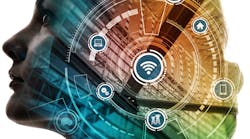An AI system can enable such services as predictive maintenance, which multiplies the value of the Internet of Things (IoT). “With AI, users can learn patterns that lead to failures and make predictions such as construction equipment failing if it is not serviced after a certain amount of time,” Maciej Kranz, of Cisco, explains. “The AI system might also recommend how to operate the equipment to maximize its useful life, offering trade-offs between performance and longevity.”
Machine learning makes the analytics systems “smarter” as time goes on and more data sets and patterns are available. Kranz makes the analogy that AI is the brain and IoT is the body, with IoT providing both input (data) and output (action) for the smart computing and analytics function of a centralized AI system. “By working smarter together, users can make better day-to-day or planning decisions, whether on a construction site or in a manufacturing facility or in a retail store,” says Kranz.
AI Is Here to Stay
According to a study by Harvard Business Review, 60% of respondents stated that their company’s future success depends on the implementation of artificial intelligence. Another 36% indicated their organizations were in pilot or production use with machine-learning technology.
AEM offers guidance on overcoming barriers to AI adoption and its long-term implications for construction through CONEXPO-CON/AGG 365 online. Although this type of technology can better empower construction teams to handle critical tasks, several challenges are holding back widespread adoption that needs to be addressed first before finding success with artificial intelligence. These include:
The fearamong workers—Some employees believe that AI is a job killer and that it will require a deeper understanding of data science. However, as newer tools come out, AI is becoming an easier-to-use tool.
Cultural resistance—A cultural resistance to groundbreaking technologies exists and needs to be overcome. Kranz emphasizes that it is important that people understand AI is here, and that movement on adoption should be a priority, but only once a company’s needs and values have been assessed.
Security—From an IT perspective, security is a huge issue, and the security industry is finally addressing the special requirements of IoT, inclusive of AI, according to Kranz. “Just as they responded to Wi-Fi 15 years ago, they are now focusing on security standards, interoperability, and certifications, from the device level through the network and to the cloud.”


